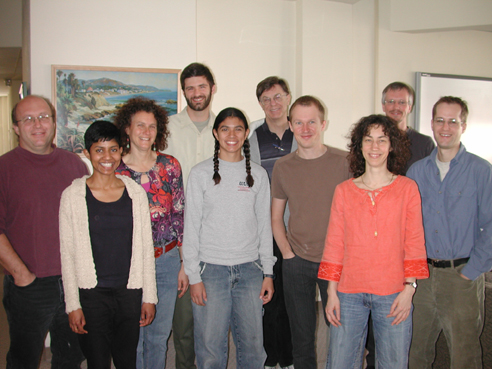NCEAS Working Groups
Evolutionary and ecological sorting in space
Project Description
The last fifteen years have witnessed an increasing realization that ecological dynamics operating at coarse spatial scales have important ecological consequences. One of the more exciting ideas that has ensued is the "metacommunity" (Figure 1), a concept that has contributed significant insights about population, community and ecosystems ecology (see Leibold et al. 2004 for a recent review, Holyoak et al. 2005 for the scope of this idea).
To date, however, the metacommunity concept has been evaluated in a purely ecological context. Nevertheless, close parallels and obvious interrelations exist between ecological and evolutionary dynamics at multiple spatial scales (McPeek and Gomulkiewicz 2005). Mounting evidence suggests that evolutionary dynamics can occur on time scales similar to those involving ecological dynamics (Cousyn et al. 2001, Kinnison and Hendry 2001, Grant and Grant 2002, Yoshida et al. 2003). If so, metacommunity and evolutionary dynamics may interact strongly. Yet, we are only now beginning to understand this interaction. While metacommunity ecology will continue to contribute interesting insights about a diverse array of ecological phenomena, we foresee that these insights will soon be constrained by our limited knowledge about how ecological and evolutionary processes interact in metacommunities.
We seek to bring together scientists from diverse backgrounds to synthesize current knowledge and generate new understanding about evolutionary and metacommunity dynamics. We intend to 1) develop and refine an evolving metacommunity framework, 2) explore the potential for emergent dynamics by incorporating evolution into existing metacommunity models; 3) evaluate how multi-species interactions impact community evolution and dynamics; and 4) develop tools to test and apply the theory. The proposed synthesis of evolutionary and metacommunity theory promises to improve our understanding of species coexistence and provide strategies for preserving biodiversity and controlling rapidly evolving pests and pathogens.

Principal Investigator(s)
Mark C. Urban, Mathew A. Leibold
Project Dates
Start: March 20, 2006
End: January 11, 2008
completed
Participants
- Priyanga Amarasekare
- University of California, Los Angeles
- Jeannine M. Cavender-Bares
- University of Minnesota, Twin Cities
- Steven Declerck
- Katholieke Universiteit Leuven
- Claire de Mazancourt
- McGill University
- Luc De Meester
- Katholieke Universiteit Leuven
- Richard Gomulkiewicz
- Washington State University
- Matthew R. Helmus
- University of Wisconsin, Madison
- Michael E. Hochberg
- Université de Montpellier II
- Christopher Klausmeier
- Michigan State University
- Mathew A. Leibold
- University of Texas, Austin
- Curtis M. Lively
- Indiana University
- Nicolas Loeuille
- University of Texas, Austin
- Jon Norberg
- Stockholm University
- Scott Nuismer
- University of Idaho
- Otso Ovaskainen
- University of Helsinki
- Jelena Pantel
- University of Texas, Austin
- Christine Parent
- Simon Fraser University
- Pedro Peres-Neto
- Université du Québec, Montreal
- Sharon Strauss
- University of California, Davis
- Mark C. Urban
- Yale University
- Mark Vellend
- University of British Columbia
- Michael Wade
- Indiana University
Products
-
Journal Article / 2006
Phylogenetic structure of floridian plant communities depends on taxonomic and spatial scale
-
Presentations / 2007
Evolution and our understanding of the ecology of aquatic systems
-
Presentations / 2007
The interface between evolution and ecology: Genetic diversity matters
-
Presentations / 2008
Evolutionary dynamics in a metacommunity context
-
Presentations / 2008
The impact of evolution in a metacommunity context
-
Presentations / 2008
Testing the feedback of evolution on ecology in zooplankton communities
-
Presentations / 2008
Dynamic patterns of fitness and diversity of coevolving hosts and parasitoids within a metacommunity
-
Journal Article / 2010
A framework for community interactions under climate change
-
Presentations / 2008
Fundamental changes in metacommunity dynamic through evolution
-
Journal Article / 2008
Floquet theory: A useful tool for understanding nonequilibrium dynamics
-
Journal Article / 2010
Metacommunity phylogenetics: Separating the roles of environmental filters and historical biogeography
-
Journal Article / 2015
Species sorting and patch dynamics in harlequin metacommunities affect the relative importance of environment and space
-
Presentations / 2008
Evolution of specialization in (meta)communities
-
Presentations / 2008
Evolution by neutral and niche-based ecological processes in simulated and real metacommunities
-
Journal Article / 2012
Ecophylogenetics: Advances and perspectives
-
Journal Article / 2012
Eco-evolutionary responses of biodiversity to climate change
-
Presentations / 2008
Qualifying the interaction between microevolution and metacommunities
-
Data Set / 2007
Lizards in Baja California
-
Journal Article / 2008
The evolutionary ecology of metacommunities
-
Presentations / 2008
The metacommunity monopolization effect: Priority effects and evolution shape community assembly
-
Presentations / 2009
A very complex adaptive system: The evolutionary ecology of metacommunities
-
Journal Article / 2009
Community monopolization: Local adaptation enhances priority effects in an evolving metacommunity
-
Presentations / 2008
Relative roles of species sorting and evolution for determining biodiversity under climate change
